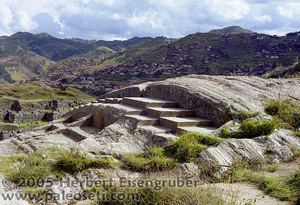 |
First there this
structure right across the fortress Saqusayhuaman (you can see it in
the
background) that is cut right out of the rock. It's called the "Inca's
throne", because it is believed that the Inca emperor watched the
construction of the great wall from there.
|
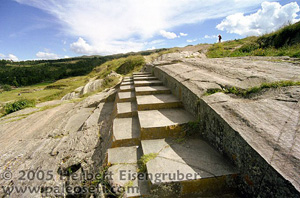 |
Here a closer look at the
Inca's
throne. Please look at the razor sharp edges and the precision of the
cuts.
Official archeology tells us that this was achieved with crude stone
tools. Can
you imagine how long it would have taken just to carve or cut one step?
No, I
think a different technology was used here. See below for my
explanation.
|
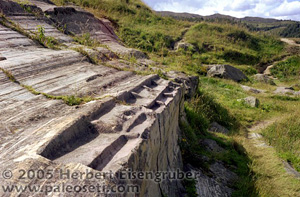 |
A little further you
will find this structure. This certainly was not a throne... |
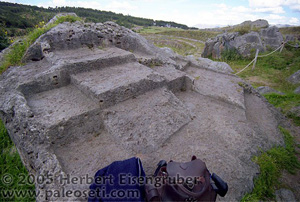 |
And then it
get's really
strange!
This rock looks like it was carved with a butter knife. The theory that
the rock carvings up here was simply the quarry for the wall of the
fortress doesn't work. Some of the carvings up here are much older then
the wall of the Saqsayhuaman fortress. Also the rocks in the wall have
irregular
shapes while the cut outs here are straight. Also the cuts in the rocks
up here are polished. If this would have been a simple quarry,
polishing the rock would not have made sense.
|
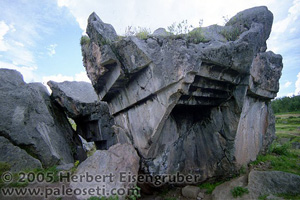 |
... an then you mouth
will just stay open. Steps are running from top to the bottom. |
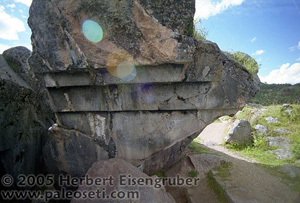 |
the same stone block
as seen from the side.
|
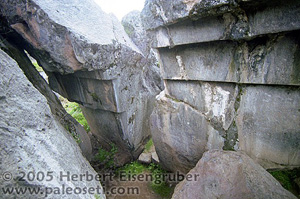 |
Up here every rock
was carved. Walls were cut lick butter and polished. Everything looks
as it was
cast in concrete. But the rock is not concrete, but natural grown
granit. It is
also very strange that the rocks are carved in places were an artist
can't
reach with a chissel or similar. You can see that in this photo on the
rock in
the background. Everything up here looks as it was put upside down.
|
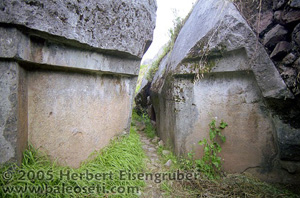 |
A whole
"labyrinth" was carved out here.
|
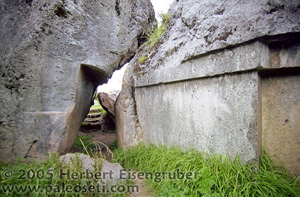 |
Everything was
polished. You can guide your hand across the rock surface without
feeling rough
spots or a raised area. |
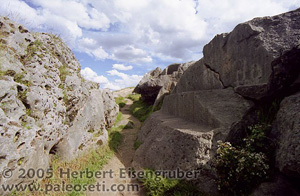 |
Everything was
carved! You can walk around for hours and find something new behind
every
corner. |
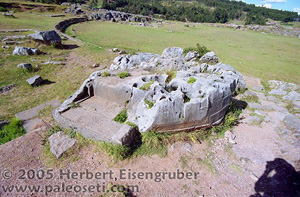 |
Please take your time
and study this rock a bit closer. You will see that EVERYTHING on it
was
carved. Why were rocks up here carved the way they are?
In the background you can see a big round field. It's really a gigantic
stone
circle as it is completely surrounded by rocks. The area is certainly
artificially made. |
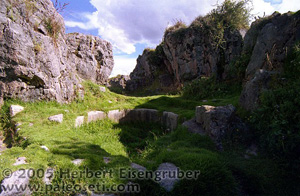 |
Everywhere you can
find stones that are carved in the typical Inca style. Like this small
stone
circle here.
|
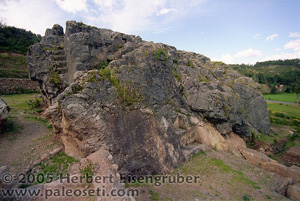 |
But there is even
better stuff! This monster rock is about 40m long, 30m wide and 20m
high.
According to the legend, this rock was once moved (!) and buried 3000
workers
when it fell.
I can't tell if that's true or not, but it's a fact that the whole
block was
carved. Again you see steps running upside-down. See next photo.
|
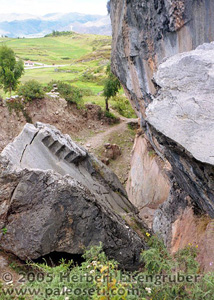
|
Again you can walk
for hours in the area above Saqusayhuaman. Everything up here was
carved and
artificially arranged. And this not only in a small area. In a Taxi I
drove on
the road that leads to Pisaq. Left and right next to the road over a
distance
of at least 7 kilometers one can see carved rocks that look as they
were turned
upside down. It almost seems as if there was an ancient city long, long
before
the Inca. And it also seems the Inca built there stunning buildings on
those
ancient remains. Did the Inca inherit the tools to carve there
magnificent
stoneworks from this older culture? Or did they find the tools with
which the
older structures were built with? |
|
|

